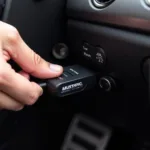The VTEC pressure switch plays a crucial role in engaging your Honda’s Variable Valve Timing and Lift Electronic Control (VTEC), which boosts engine performance at higher RPMs. A malfunctioning switch can trigger the dreaded check engine light and potentially hinder your engine’s power. In this comprehensive guide, we’ll delve into the intricacies of a VTEC pressure switch bypass OBD2, exploring its implications and providing you with the knowledge you need.
Understanding the VTEC System and Pressure Switch
Before we explore the bypass procedure, let’s establish a clear understanding of the VTEC system and the vital role of the pressure switch.
What is VTEC?
VTEC is a valve control system that optimizes engine performance across different RPM ranges. At lower engine speeds, VTEC utilizes a fuel-efficient camshaft profile. As the engine revs higher, the VTEC system engages a more aggressive camshaft profile, delivering increased power and torque.
The Role of the VTEC Pressure Switch
The VTEC pressure switch, often located near the oil filter or on the cylinder head, is responsible for monitoring oil pressure within the engine. When the oil pressure reaches a specific threshold, typically around 3,000-4,000 RPM, the switch sends a signal to the Engine Control Unit (ECU). The ECU then activates the VTEC solenoid, engaging the high-performance camshaft profile.
What is a VTEC Pressure Switch Bypass OBD2?
A VTEC pressure switch bypass OBD2 essentially involves bypassing the pressure switch and sending a constant signal to the ECU, tricking it into thinking the required oil pressure for VTEC engagement is always present. This is often achieved by creating a direct electrical connection that simulates the signal sent by the pressure switch.
Reasons for Performing a Bypass
There are several reasons why someone might consider a VTEC pressure switch bypass OBD2:
- Troubleshooting: A bypass can help isolate the pressure switch as the source of VTEC-related issues.
- Testing VTEC Solenoid: Bypassing the switch allows you to directly activate the VTEC solenoid and test its functionality.
- Performance Modifications: Some enthusiasts bypass the switch to engage VTEC at lower RPMs, potentially enhancing low-end torque.
Important Note: It’s crucial to emphasize that bypassing the VTEC pressure switch is not a long-term solution and can have potential drawbacks, especially if performed incorrectly or without proper understanding.
Potential Risks and Considerations
Before attempting a VTEC pressure switch bypass OBD2, it’s essential to be aware of the potential risks and considerations:
- Engine Damage: Bypassing the switch means the ECU won’t receive accurate oil pressure readings. If VTEC engages without sufficient oil pressure, it can lead to severe engine damage.
- False Positives: Bypassing the switch might mask underlying engine problems related to oil pressure, potentially leading to more significant issues down the line.
- Warranty Void: Modifying your car’s electrical system, including bypassing the VTEC pressure switch, can void your vehicle’s warranty.
Alternatives to Bypassing
Instead of resorting to a bypass, consider these alternatives:
- Thorough Inspection: Before assuming the pressure switch is faulty, inspect the wiring harness, connectors, and related components for any damage or loose connections.
- Pressure Switch Replacement: If the pressure switch is confirmed to be faulty, replacing it with a new OEM or high-quality aftermarket unit is the recommended solution.
- Professional Diagnosis: If you’re unsure about the source of your VTEC issues, seeking assistance from a qualified mechanic specializing in Honda vehicles is always advisable.
Conclusion
While a VTEC pressure switch bypass OBD2 might seem like a quick fix or performance enhancement, it’s crucial to proceed with caution and a thorough understanding of its implications. Remember that tampering with your vehicle’s electrical and engine management systems can have unintended consequences. Prioritizing proper diagnosis, maintenance, and seeking professional guidance when needed is always the safest and most effective approach to ensure your Honda’s performance and longevity.
